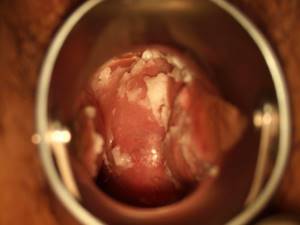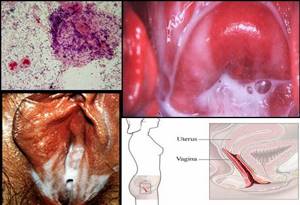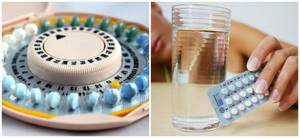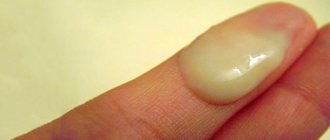Symptoms
You shouldn’t get too scared right away; first you need to understand the nature and analyze the nature of mucus during intimacy. Based on the characteristics of the manifestation, the following types of discharge during sex can be determined.
Viscous and white
If there is no unpleasant odor, no pain, no discomfort during intimacy, as well as after it, then most likely you are healthy. Over the entire period of the menstrual cycle, the nature of vaginal fluid changes. During ovulation, it becomes viscous like egg white and whitish, the environment in the vagina becomes alkaline. This is how the body prepares for possible conception.
Also, during sexual intercourse, for several days after it, sperm is released in white clots, especially if the partner’s consistency is thick and white.
You should also take into account the characteristics of the body, each woman has her own vaginal secretion, and for some it is quite thick and abundant, which causes white discharge during sexual intercourse.
With a cheesy consistency and sour smell

This kind of discharge during sex most often indicates thrush or candidiasis. In this case, itching, swelling of the genital organs, and discomfort during intercourse are possible. Characteristic whitish cheesy clots remain on the man's penis, as well as at the entrance to the vagina. An unpleasant sour smell appears.
White with red veins
Discharge of this kind during sex occurs due to erosion of the cervix, as well as injuries to the genital organs. It is especially dangerous if you observe white mucus with red streaks on the pad, which indicates serious diseases of the uterus, including neoplasms.
Green with a pungent, repulsive odor
This kind of discharge during intimacy indicates serious sexually transmitted diseases, such as chlamydia, gonorrhea, and trichomoniasis. These diseases manifest themselves as pain in the lumbar spine and lower abdomen. Sexual intercourse must be stopped during the treatment period.
Read also Cracks on the penis
An unpleasant odor occurs due to the proliferation of a large number of bacteria on the vaginal mucosa, which, consuming nutrients, release foul-smelling waste products.

Liquid and yellowish
This kind of discharge in women is typical before ovulation or a few days before menstruation. This mucus itself has a yellowish tint, which is clearly visible if you wear one pad without changing it all day. If the discharge becomes bright yellow, this indicates an infectious infection.
White with an unpleasant odor

A rather dangerous symptom, signaling an infectious lesion of the vaginal mucosa. Symptoms of this kind appear with bacterial vaginosis and vaginitis.
Vaginitis is accompanied by a strong desire to scratch the genitals during sexual intercourse and copious, foamy discharge. When this disease becomes chronic, the discharge becomes thick, profuse, and white.
Bacterial vaginosis in women is characterized by pain in the lower abdomen and profuse white discharge that has an unpleasant ammonia (fishy) odor. If you notice such symptoms, you should visit a gynecologist. During the treatment period, the girl must avoid sexual contact with her partner to prevent infection. If both are sick, then sex should also be avoided until the partners have fully recovered.
Normal discharge
White, transparent and yellow leucorrhoea is the color of healthy leucorrhoea and the physiological normal process in a woman’s body. The process arises in connection with the health of the body and the cleanliness of the woman. A normal secretion is odorless or sour because it consists of lactobacilli and a slightly acidic environment. It is she who allows you to easily conceive a child and carry him to term.

What should a healthy woman's discharge be like? The vagina and outer labia are provided with lubricant or leucorrhoea, which is considered normal for women or girls.
There are certain signs that determine the line between normal and pathological. Every woman should know which physiological process is normal and which is pathological for health.
The shade of the secretion is affected by the period of the cycle. Normal leucorrhoea is creamy, white, clear, or yellow in color. Leucorrhoea has no smell. Their consistency can be either liquid or viscous. The amount of discharge per day should not exceed the volume of a teaspoon. Before the onset of menstruation and after intimacy (sexual arousal), mucus may increase in quantity.
Influencing factors
The first discharge appears in girls immediately after birth. This process is associated with the hormonal background of the mother. Later they disappear and appear in adolescence.
A woman's vaginal mucus may depend on:
- menstrual cycle.
- hormonal conditions.
- ovarian activity.
- general health.
- age.
- sexual activity.
Composition of the secret
Most women consider discharge to be a pathological and unnatural process. However, they play a primary role in the reproductive system and maintaining women's health.
Causes
When they detect uncharacteristic white discharge during sex, women look for reasons why this happened, blaming themselves or their partner, since problems of this kind are quite delicate. The following are the main causes of white discharge during sexual intercourse:
Stress and weakened immunity

With the frantic modern rhythm of life and stress in the form of children, husband, family, work, gardening, women often forget about themselves and their health. There is no time or energy left for self-care and a full-fledged sex life. The result of all this is various diseases in the intimate area.
Very often, young women develop candidiasis after undergoing psychological experiences. It is the result of a malfunction in the immune system and the death of lactobacilli on the vaginal mucosa.
Another dangerous disease that is the scourge of our time is genital cancer. It occurs three times more often in women than in men. Constant nervous tension and resentment accumulate in the body and begin to destroy from the inside, manifesting itself in the form of tumors, neoplasms and uncharacteristic discharge.
Changes in hormonal levels
Hormonal deviations now exist in almost every girl. This is due to the environment and the use of various contraceptives.
Using contraceptives too frequently can destroy the vagina's natural defenses and make it more vulnerable to pathogens.

Oral contraceptives are especially dangerous in this regard, causing an imbalance in the female body by suppressing ovulation. Spermicides can also cause itching and white discharge, which contribute to vaginal dryness and discomfort during sex.
Read also: What sexually transmitted diseases can occur in the mouth
Promiscuity and unprotected sex
Despite the promotion of a healthy lifestyle and the variety of types of barrier protection, the number of representatives of the fair sex who have been exposed to sexually transmitted infections is only growing. Why this happens is quite difficult to understand, but the answer should be sought in the psychology of women, in their moral character and self-awareness.
Perhaps, in pursuit of thrills and sexual experiments, one should be more discerning and careful in matters of intimate life.
Sexually transmitted diseases do not leave the body of young women without leaving a trace. In the future, problems with conception and ectopic pregnancy are possible.
Unhealthy Lifestyle
Eating fatty foods and smoking cause deterioration of the skin and mucous membranes of the female body. This causes the death of beneficial microorganisms and promotes alkalization of the mucous membrane in the intimate area.
The use of alcohol, drugs and other psychotropic drugs weakens a woman’s vitality, which is manifested in a decrease in the tone of the uterus and its erosion. Vaginitis or vaginosis and sexual disorders are also possible.
Why doesn't a girl have lubrication when she's aroused?

If a woman does not have lubrication even at the moment of strong sexual arousal, during sexual intercourse, and at its end, most likely, we will talk about the presence of disorders and disorders. From a medical point of view, atrophic vaginitis is a direct microdamage, which is accompanied by a decrease in the secretion of glands in the walls of the vagina. Against this background, natural lubrication is not produced by the genitals.
| The most powerful method of penis enlargement. The penis has grown by +5.5 cm. You just need... Read more >>> |
Reasons why lubricant stopped releasing:

- If we talk about women aged 40-60 years, the cause may be menopause. Against the background of such a change in the body, the level of estrogen production by the hormonal system, which is primarily responsible for the functioning of the glands, decreases.
- A decrease in estrogen can be caused by taking hormonal medications such as antidepressants, antihypertensive medications, fibroid medications, antihistamines and diuretics.
- Personal hygiene items that are chosen incorrectly can also affect the functioning of the genitals and glands. Namely, products with fragrances, fragrances, synthetic substances and dyes.
- Taking hormonal drugs with progesterone, which acts as an estrogen antagonist, can lead to a decrease in lubrication.
- Physiological reasons are the premenstrual period, as well as menstruation.
- Women who abuse bad habits may have little lubrication, which affects the circulatory system and the functioning of the secretory glands, as well as hormonal levels.
- The influence of radiation and chemotherapy, which has an extremely negative effect on the functioning of the hormonal system.
- The cause may also be the autoimmune disease Sjögren's syndrome, which affects various glands and affects connective tissue.
- Dryness can also be caused by a number of negative factors - frequent douching, the presence of genitourinary infections and viral diseases, as well as surgery to remove the ovaries.
- The most common cause of a lack of secretions in a woman is the period of pregnancy and the postpartum stage, when the hormonal system undergoes a restructuring.
Also, the causes of atrophic vaginitis include frequent stressful situations, physical overload, and psycho-emotional disorders.
Diagnosis and treatment of white discharge

If you notice any unpleasant symptoms, you should definitely see a specialist. There is no need to panic right away, since white discharge may just be a feature of the body.
If a certain disease is suspected, the gynecologist will conduct additional studies, such as:
- smear microbiology;
- Ultrasound of the abdominal cavity;
- advanced blood and urine analysis;
- colposcopy.
Depending on the type of disorder, the doctor will develop the necessary treatment regimen, selecting the optimal recovery program. To summarize, sexual disorders can be divided into two main groups.
Endogenous
They are not associated with various types of infection and are caused by the internal state of the woman’s body. These include thrush, cancer, hormonal imbalances, and erosion.
For their treatment, a complex of immunomodulatory and sedatives is selected, such as iodine preparations, the use of immunoglobulins, bio- and enzyme preparations. Separately here, of course, is the treatment of cancer, which often requires surgical intervention.
Exogenous
These include sexually transmitted diseases and all kinds of sexually transmitted infections received from a partner. This group also includes genital injuries resulting from accidents, such as violence or domestic injuries.
For treatment, a special complex of drugs with general and specialized action is selected. Surgery is possible.
If you detect alarming symptoms in the form of incomprehensible discharge, you should not go to extremes, but you should not treat your own body negligently. Periodic examinations by a gynecologist, proper nutrition and a healthy lifestyle will help you avoid or stop various sexually transmitted infections at an early stage.










